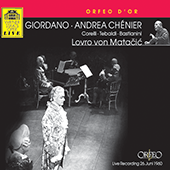Renata Tebaldi
Before Tebaldi was born her cellist father and her mother had separated. Her mother, a nurse, subsequently settled with her own family in the small town of Langhirano, outside Parma. At the age of three Tebaldi contracted poliomyelitis, which was cured after five years of intensive nursing, bringing mother and child close. She sang in the Langhirano church choir and when she was thirteen her mother arranged for her to have piano lessons in Parma with Giuseppina Passani, who later suggested that she study singing. Tebaldi felt that this enabled her to express herself fully, studying with Italo Brancucci at the Parma Conservatory, which she entered when she was seventeen. Later she studied voice there with Ettore Campogalliani and was subsequently a pupil both of the distinguished soprano Carmen Melis at the Pesaro Conservatory and with Giuseppe Pais, with whom she long maintained contact.
Tebaldi made her operatic stage debut in 1944 as Elena in Boito’s Mefistofele at Rovigo, shortly after which she sang Mimì / La Bohème, Maddalena / Andrea Chénier and Suzel / L’amico Fritz at Parma. She attracted attention when she first sang Desdemona / Otello opposite Merli at Trieste in 1946. Subsequently she auditioned successfully for Toscanini at La Scala, Milan and took part in the concerts to mark the reopening of this theatre, singing the prayer from Rossini’s Mosé and in Verdi’s Te Deum. She then sang Marguerite / Faust, Elsa / Lohengrin and Elena at La Scala, followed by Mimì and Eva / Die Meistersinger von Nürnberg. With Toscanini’s active support and tuition she sang Aida for the first time at La Scala in 1950 and her international career was launched.
During this period Tebaldi sang widely in Italy: her repertoire encompassed Violetta / La traviata, Elisabeth / Tannhäuser and the title role in Tosca as well as parts associated with the post-war bel canto revival in Italy such as Pamira / L’assedio di Corinto and Matilda / Guglielmo Tell plus the title roles in Spontini’s Olimpia and Agnes di Hohenstaufen and Verdi’s Giovanna d’Arco. She made her debuts at the Edinburgh Festival and the Royal Opera House, London with the La Scala company on tour in 1950 as Desdemona and in the Verdi Requiem with De Sabata conducting, winning high praise.
During a concert given with Maria Callas in Rio de Janeiro during 1951 an intense rivalry erupted between the two sopranos which was to last until 1968. With Callas dominating La Scala in the bel canto repertoire, Tebaldi gradually refocused her own repertoire upon roles in late nineteenth- and early twentieth-century operas, such as Leonora / La forza del destino, Tatyana / Eugene Onegin and the title roles in Catalani’s La Wally and Cilea’s Adriana Lecouvreur.
Following a single USA appearance as Aida in 1950, Tebaldi made her debut at the Metropolitan Opera, New York at the beginning of 1955 as Desdemona to an ecstatic reception. Henceforth the Met was to be the focus of her career (although she did continue to give a limited number of performances in Europe, for instance in Amsterdam, Barcelona, Berlin, Paris and Vienna; also notably as Tosca at Covent Garden in 1955, some performances in Naples and a farewell recital at La Scala in 1976). Her roles at the Met included Mimì, Maddalena, Tosca, the Forza Leonora, Violetta, the title roles in Madama Butterfly and Manon Lescaut and Amelia / Simon Boccanegra. At the beginning of 1963 she sang Adriana Lecouvreur in a new production mounted for her, but experienced vocal difficulties. She therefore took time off to refocus her technique before returning as Mimì in the spring of 1964 and continuing to sing a similar repertoire as before, adding the title role of La Gioconda in the autumn of 1966, Minnie / La fanciulla del West in 1970 and Mistress Ford / Falstaff in 1972. She gave her final performance at the Met as Desdemona at the beginning of 1973.
Although Tebaldi did not teach formally she did advise several emerging singers, such as Aprile Millo. At the start of her career she signed an exclusive contract with Decca, for whom she recorded virtually her entire repertoire: together they made twenty-seven complete opera recordings between 1951 and 1970. These recordings gave her an international presence granted to few singers. While they are extremely polished, her intensely dramatic side may also be seen in certain ‘live’ recordings.
On stage Tebaldi, who was very tall, presented a statuesque figure. She possessed a meltingly beautiful soprano voice and the ability, to quote the eminent Italian music critic Rodolfo Celletti, to realise ‘so many gradations of colour and intensity as to fill the entire palette that goes from light-lyrical soprano to dramatic soprano’.
© Naxos Rights International Ltd. — David Patmore (A–Z of Singers, Naxos 8.558097-100).

















